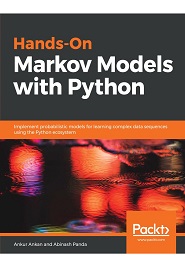
English | 2018 | ISBN: 978-1788625449 | 178 Pages | PDF, EPUB | 91 MB
Unleash the power of unsupervised machine learning in Hidden Markov Models using TensorFlow, pgmpy, and hmmlearn
Hidden Markov Model (HMM) is a statistical model based on the Markov chain concept. Hands-On Markov Models with Python helps you get to grips with HMMs and different inference algorithms by working on real-world problems. The hands-on examples explored in the book help you simplify the process flow in machine learning by using Markov model concepts, thereby making it accessible to everyone.
Once you’ve covered the basic concepts of Markov chains, you’ll get insights into Markov processes, models, and types with the help of practical examples. After grasping these fundamentals, you’ll move on to learning about the different algorithms used in inferences and applying them in state and parameter inference. In addition to this, you’ll explore the Bayesian approach of inference and learn how to apply it in HMMs.
In further chapters, you’ll discover how to use HMMs in time series analysis and natural language processing (NLP) using Python. You’ll also learn to apply HMM to image processing using 2D-HMM to segment images. Finally, you’ll understand how to apply HMM for reinforcement learning (RL) with the help of Q-Learning, and use this technique for single-stock and multi-stock algorithmic trading.
By the end of this book, you will have grasped how to build your own Markov and hidden Markov models on complex datasets in order to apply them to projects.
What you will learn
- Explore a balance of both theoretical and practical aspects of HMM
- Implement HMMs using different datasets in Python using different packages
- Understand multiple inference algorithms and how to select the right algorithm to resolve your problems
- Develop a Bayesian approach to inference in HMMs
- Implement HMMs in finance, natural language processing (NLP), and image processing
- Determine the most likely sequence of hidden states in an HMM using the Viterbi algorithm
Resolve the captcha to access the links!